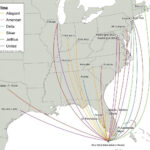Navigating airport security can often feel like a maze of regulations and requirements. With the increasing focus on secure identification, many travelers are left wondering: Do You Need A Star Card To Fly? This question is particularly relevant in light of the Real ID Act and its impact on domestic air travel within the United States. Let’s clarify what a Star Card is, whether you need one to fly, and what other forms of identification are acceptable at airport security checkpoints.
What is a Star Card and Real ID?
The Star Card, often referred to as a Real ID, is a driver’s license or identification card that meets specific security standards set by the U.S. federal government. These standards are a result of the Real ID Act, passed by Congress in 2005 following recommendations from the 9/11 Commission. The aim of the Real ID Act is to establish minimum security standards for state-issued driver’s licenses and identification cards to enhance security and prevent terrorism. A Star Card indicates that your state-issued ID complies with these federal Real ID requirements.
Do You Actually Need a Star Card to Fly Domestically?
The short answer is no, you don’t strictly need a Star Card to fly domestically within the United States. However, you do need to present a Real ID-compliant identification to pass through Transportation Security Administration (TSA) checkpoints at airports.
While a Star Card is one form of Real ID-compliant identification, it’s not the only one. Starting October 1, 2020, the TSA began enforcing the Real ID requirement. This means that state-issued driver’s licenses and identification cards that are not Real ID-compliant are no longer accepted as valid identification for flying domestically. If your driver’s license is Real ID-compliant, it will typically have a star symbol (hence “Star Card”) or another marking as determined by your state, indicating its compliance.
If you do not have a Star Card or other Real ID-compliant driver’s license, you will need to present an alternative form of acceptable identification to fly.
Acceptable Forms of Identification for Flying
The TSA accepts a variety of documents as valid identification at airport security checkpoints. If you don’t have a Star Card, or even if you do, it’s helpful to know what other forms of ID are acceptable. These include, but are not limited to:
- U.S. Passport: A valid U.S. passport is always an acceptable form of identification for domestic and international flights.
- U.S. Passport Card: This is a wallet-sized card that is valid for domestic air travel and entry into the United States from Canada, Mexico, Bermuda, and the Caribbean.
- Military ID: Active duty and retired military personnel and their dependents can use their military IDs.
- DHS Trusted Traveler Cards: These include Global Entry, NEXUS, SENTRI, and FAST cards, which are issued by the Department of Homeland Security.
- Enhanced Driver’s Licenses (EDL): These are issued by a few states (Michigan, Minnesota, New York, Vermont, and Washington) and are Real ID-compliant and accepted for air travel.
- Tribal ID: Federally recognized tribal-issued photo IDs are accepted.
- Transportation Worker Identification Credential (TWIC): This card is for workers who require unescorted access to secure areas of maritime facilities and vessels.
For a complete and up-to-date list, it’s always best to check the TSA’s official website before you travel.
Why Get a Star Card?
While a Star Card is not the only way to fly, it offers a significant convenience for domestic air travel. For many people, a driver’s license is the most commonly carried form of photo identification. Obtaining a Star Card simply ensures that your driver’s license will continue to be a valid form of ID for flying domestically, without needing to remember to bring a passport or other specific document.
Furthermore, Real ID-compliant identification, like a Star Card, is also increasingly required for accessing federal buildings and military bases. Getting a Star Card can simplify various identification needs beyond just air travel.
How to Obtain a Star Card
The process for obtaining a Star Card varies slightly by state, but generally involves visiting your state’s Department of Motor Vehicles (DMV) or equivalent agency and providing documentation to prove your identity, social security number, and U.S. residency. It’s important to check your state DMV’s website for specific requirements and to ensure you bring all necessary documents with you to your appointment.
Conclusion
In summary, while you technically don’t need a Star Card to fly, you do need Real ID-compliant identification. A Star Card is simply a state-issued driver’s license or ID card that meets these requirements, making it a convenient option for many travelers. If you prefer to use other forms of acceptable ID like a U.S. passport, that is perfectly acceptable. However, for ease and convenience, especially for domestic travel, getting a Star Card can streamline your airport experience and ensure you have the necessary identification for your flight. Planning ahead and ensuring you have the correct identification, whether it’s a Star Card or another acceptable document, is key to smooth and stress-free air travel.
